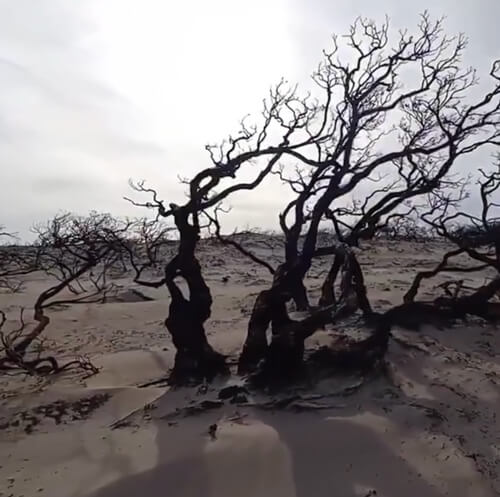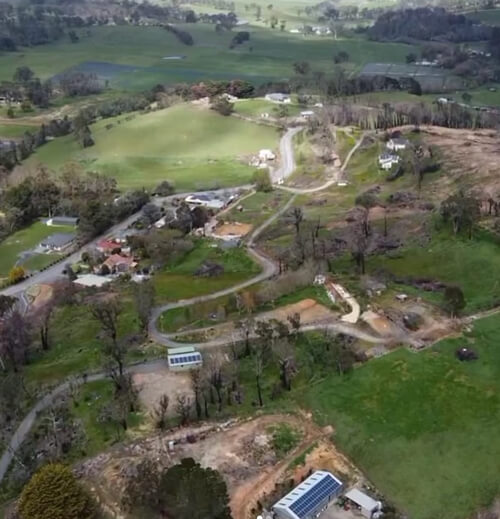Written by Jiri Lev, edited by the Australian Institute of Architects
Jiri Lev is an Australian building and urban designer. He has been working with the Australian Institute of Architects on the Architects Assist program, a network set up for architects who wish to help affected Australians rebuild after the devastating summer bushfires. In this piece, Jiri details his recent visit to some of these communities in need.
My previous two reports covered our tour from its start in Tasmania, across Victoria to New South Wales. We travelled across the vast bushfire-affected regions raising awareness of the services provided by Architects Assist contributors, making new connections and providing advice and encouragement where it was needed.
South Australia
With the East Coast part of the tour completed and Queensland border recently closed, we turned West towards South Australia. After good rainfall, the outback that welcomed us was green and in flower.
To avoid a 14-day quarantine, we travelled directly through to Northern Territory, where quarantine was limited only to those who had been to specific hotspots.
The five-day drive from Northern NSW to the Red Centre afforded us a new understanding of the vastness and diversity of the Land. Our arrival at Uluru campground was timely, as my Architecture Practice Examination test was due the next day via online proctoring session.
Despite being thousands of kilometres away from the regions affected by the fires, we kept making connections with people curious about our cause: many South Australians were in the NT on their first break since the disaster that ravaged their communities.
Re-entering SA from NT 14 days since leaving NSW, we resumed our work, beginning in Yorke Peninsula. The fires there had coincided with the harvest time. Dry crops and high winds typical for the region allowed the flames to spread rapidly across the vast, treeless plains. A number of homes were destroyed in Edithburgh and surrounding towns.
It is not commonly understood that proximity to bushland and BAL rating forms only a small part of the complex climate resilience mosaic.
Our next visit was at Kangaroo Island, where the high content of iron in the ground attracts frequent dry lightning and the native vegetation is well adapted to regular fire; in fact, many species depend on it for their flowering or seed germination.
The last fires unfortunately coincided with the peak of a prolonged drought and strong, hot winds from the central deserts. Once lit, the element spread quickly. Many roadside nature strips protected by conservation against clearing or hazard reduction acted like wicks, allowing the fires to traverse otherwise cleared land. The island lost about half of its native bushland and over 90 homes.

In many instances, what insurance money there was available was first spent on replacement of farm fencing and infrastructure, which is the community’s livelihood. Many are left living in improvised conditions. The relative isolation of the island and labour shortage further complicates matters. Like in many other regions we visited, the endured distress is only now beginning to show its full devastating psychological impact.
At the same time, it was amazing to witness the resilience of the community, matched only by that of its natural surroundings: in the sharp winter sun the blackened tree trunks were sparkling with fresh new leaves, and countless grasstrees displayed their towering flowers.
Local recovery officers are now looking to engage Architects Assist members for talks, workshops and assistance with rebuilding homes and community facilities. One such workshop had already been organised and delivered by Adelaide architect Lu Balsamo and a group of Architects Assist contributors in Adelaide Hills. When we arrived in the region, it was encouraging to learn that many locals had already been utilising the assistance available to them.
Following a couple of last stops at localities further South, we arrived at our final overnight stay on the mainland, strategically chosen in the wine region of Coonawarra. Here we could stock up provisions for our mandatory 14-day self-isolation in Tasmania.
We were disappointed that we could not visit the bushfire-affected communities in Victoria due to the COVID-19 lockdown. However, we’ve managed to engage with their local and state bushfire recovery coordinators remotely and are confident that many communities are now aware of the Architects Assist services.
From Coonawarra, we then drove straight through the presently quiet Victorian countryside and metropolitan Melbourne to the Spirit of Tasmania terminal. After about 7 weeks and 15,000 kilometres, we’ve now arrived back in Tasmania.

ONWARD
I’d like to thank the Australian Institute of Architects for their strong ongoing support, including but far from limited to covering the initial Architects Assist website development costs.
More thanks go to the Australian Institute of Landscape Architects and Planning Institute of Australia who have joined the Australian Institute of Architects promoting Architects Assist amongst their members and audiences.
Despite its integration within the Institute, Architects Assist is ultimately a grassroots movement. We operate voluntarily and do not receive nor ask for any donations or funding.
Architects Assist member, architect David Brown commented that “the role of the architect in assisting people affected by natural disaster is not limited solely to design and architecture. We help clients come to terms with their situation and work through their options, while listening to their stories and grieving. By providing positive inspirational ideas, support and assistance we help clients to move forward.”
It has been heart-warming hearing about projects initiated through the Architects Assist network; be it a modest artist’s cottage in Victoria’s Gippsland by Pete Collings Architect, a $2.5M food hub in South Australia’s Adelaide Hills by Butcher Brown Architects, or the interesting variety of 6 ongoing bushfire recovery projects by Dickson Rothschild Architects spread across Southern NSW.
These are just a few of the projects we are aware of and those are a fraction of all the work likely being undertaken.
Our work as built environment professionals may not be as time critical as that of medical or legal professionals, however it is equally vital to a functioning society. Architects Assist seeks to promote equity of access to architecture. I maintain the opinion that access to sustainable, resilient, healthy and beautiful living environments is not a luxury, but a pragmatic necessity and an often neglected human right.